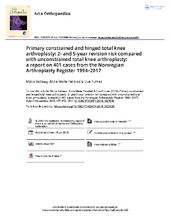| dc.contributor.author | Badawy, Mona | en_US |
| dc.contributor.author | Fenstad, Anne Marie | en_US |
| dc.contributor.author | Furnes, Ove | en_US |
| dc.date.accessioned | 2020-06-10T11:08:37Z | |
| dc.date.available | 2020-06-10T11:08:37Z | |
| dc.date.issued | 2019-06-18 | |
| dc.Published | Badawy M, Fenstad F, Furnes O. Primary constrained and hinged total knee arthroplasty: 2- and 5-year revision risk compared with unconstrained total knee arthroplasty: a report on 401 cases from the Norwegian Arthroplasty Register 1994-2017. Acta Orthopaedica. 2019;90(5):467-472 | eng |
| dc.identifier.issn | 1745-3674 | |
| dc.identifier.issn | 1745-3682 | |
| dc.identifier.uri | https://hdl.handle.net/1956/22521 | |
| dc.description.abstract | Background and purpose — The number of primary, highly constrained knee arthroplasty implants has increased with a theoretically increased risk of early failure. Therefore we analyzed the risk of all revision following total knee arthroplasty (TKA) in patients receiving a hinged or condylar constrained knee (CCK) compared with a conventional unconstrained TKA. Patients and methods — The analyses included 401 primary highly constrained or hinged implants from 1994 to 2017. Kaplan–Meier survival curves were used to evaluate time to first revision with a maximum follow-up of 20 years. Cox regression was used to calculate hazard ratio (HR) comparing condylar constrained knee (CCK), hinged, and unconstrained TKA. Results — Kaplan–Meier estimated prosthesis survival after 2 years was 94.8% (95% CI 91.4–98.2) and 93.5% after 5 years for the primary CCK and 91.0% (CI 86.6–95.4) after 2 years and 85.5% after 5 years for the primary hinged TKA. Adjusted for sex, age groups, diagnosis, time period, previous surgery, and surgery time HR was 1.4 (CI 0.8–2.3) for the CCK and 2.4 (CI 1.6–3.7) for the hinged implants. The most common cause of revision in hinged implants was infection: 14 of 22 revisions. When excluding infection as revision cause, there were no differences in survival between the implant types. Estimated survival excluding infection revisions at 5 years was 96% for unconstrained, CCK, and hinged primary TKA implants. Interpretation — Primary rotating hinge total knee arthroplasty had a higher risk of revision compared with conventional TKA after 2 and 5 years’ follow-up. Infection was the most common cause of revision. When excluding infection revisions from the survival analysis, hinged and CCK implants had similar performance to unconstrained TKA. | en_US |
| dc.language.iso | eng | eng |
| dc.publisher | Taylor & Francis | eng |
| dc.rights | Attribution CC BY | eng |
| dc.rights.uri | http://creativecommons.org/licenses/by/4.0/ | eng |
| dc.title | Primary constrained and hinged total knee arthroplasty: 2- and 5-year revision risk compared with unconstrained total knee arthroplasty: a report on 401 cases from the Norwegian Arthroplasty Register 1994-2017 | en_US |
| dc.type | Peer reviewed | |
| dc.type | Journal article | |
| dc.date.updated | 2019-12-13T14:09:02Z | |
| dc.description.version | publishedVersion | en_US |
| dc.rights.holder | Copyright 2019 The Author(s) | |
| dc.identifier.doi | https://doi.org/10.1080/17453674.2019.1627638 | |
| dc.identifier.cristin | 1743542 | |
| dc.source.journal | Acta Orthopaedica | |

